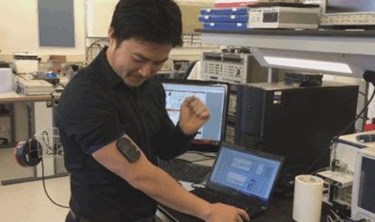Needle-Free Device Monitors Glucose With Microwaves

Scientists from Cardiff University have developed a device that attaches to the skin with ordinary adhesives and uses low levels of microwaves to keep tabs on glucose levels. Clinical testing has shown that the device’s performance is comparable to commercially available continuous glucose monitors (CGMs) and finger-stick blood tests.
Traditional glucose monitors require regular finger sticks, digital monitors, and paper testing strips that can be cost-prohibitive and inconvenient for patients, and this can interfere with patient compliance. A non-invasive alternative that can achieve the same accuracy as a blood test is the “holy grail” of diabetes management.
“Conventional methods of monitoring blood glucose require the extraction of blood,” explained Adrian Porch, who co-developed the device with Heungjae Choi, to the BBC. “Our device is non-invasive — it does not require the extraction of blood apart from the initial calibration.”
The device is slightly smaller than a fist and can adhere to the arm or to the side of the body. Once in place, the device sends microwaves into the skin, collects readings, and then transmits them to a smart device for interpretation. The device can achieve precise and continuous readings using only one mW of power, 1000 times less than what is used by the average smartphone, Porch told the BBC.
In a study that investigated the device in vivo and in vitro, researchers demonstrated a favorable comparison with commercially available glucose sensors. Further trials conducted at Swansea University’s College of Medicine by Stephen Luzio yielded an enthusiastic response from trial participants.
“Patients are very keen on this,” Luzio told the BBC. “One of the big problems with patients measuring their glucose is they don’t like pricking their finger, so there’s a lot of interest.”
Luzio plans to conduct another clinical trial this summer, and Porch and Choi project that the device could be ready for commercial market within five years.
The CDC estimates that 29.1 million people in the U.S. — 9.3 percent of the population — are diabetic, a figure that has nearly doubled in the past two decades, according to a study published in the Journal of the American Medical Association (JAMA).
Though the number of new cases is leveling off, diabetes management remains an attractive market for medtech developers because there is so much room for improvement and diversification, said Manya Aggarwal, a senior analyst at Decision Resources Group, in a column for MedDeviceOnline. Device manufacturers hoping to have success in the space, said Aggarwal, must minimize the human aspect of their devices and address compliance issues inherent with needle injections and finger sticks.
Recent research has yielded a number of potential non-invasive alternatives to the finger-stick testing. Scientists from the Technological Institute of Chihuahua in Mexico have designed a urine test for glucose management, and Korean scientists have developed a wearable patch that monitors glucose through sweat. Google and Novartis are working on a smart contact lens that tracks glucose in tears.
